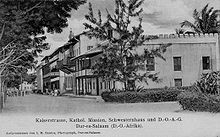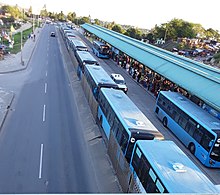Dar es Salaam
|
دار السلام Dar es Salaam Dar-es-Salam Dar es Salaam |
||
|---|---|---|
|
|
||
| Coordinates | 6 ° 49 ′ S , 39 ° 17 ′ E | |
| Basic data | ||
| Country | Tanzania | |
| Dar es Salaam | ||
| ISO 3166-2 | TZ-02 | |
| height | 12 m | |
| Residents | 5,465,400 (2016) | |
| Post Code | 12101 | |
|
Dar es Salaam city center
|
||
Dar es Salaam ( Arabic دار السلام Dār as-Salām , DMG Dār as-Salām 'House of Peace'), also Dar es Salaam or Dar-es-Salam or DSM , colloquially often only Dar for short, is the largest and economic city with around 5.47 million inhabitants and the cultural center of Tanzania . Dar es Salaam was the capital until 1974 and is still the seat of government as well as the Lutheran and Roman Catholic bishopric . Several universities are located in Dar es Salaam, and the country's largest port is also located here.
Geographical location
The city is located in the east of Tanzania on the Indian Ocean .
history

Dar es Salaam is usually equated with the ancient Rhapta , which after the Periplus Maris Erythraei (40-70 AD) was on the coast of Azania . According to the anonymous author, it got its name because of the sewn together boats ( rhapton ploiarion ) that the locals used. You could buy ivory and turtle shells here.
From 1862 the Sultan of Zanzibar , Sayyid Mâdjid, began to expand the village of Msisima; He wanted to move his residence to the mainland, gave the place the name Dar as-Salâm (Arabic: House of Peace) and began building a palace, which was not yet completed by his death in 1870.
His successor Sayyid Barghash gave up the project, but left his plantations near the city to be cultivated. In 1888 Sultan Sayyid Khalîfa leased Dar es Salaam together with the entire coast of what is now Tanzania to the German-East African Society (DOAG). August Leue was commissioned by the DOAG to set up a station. On October 28, 1890, Sultan Sayyid 'Alî sold the town and coast. From 1890 the colonial administration had set up in the small coastal town of Bagamoyo , but then Dar es Salaam, around 60 km further south, became more interesting for the Germans because of its natural harbor. Only one year later, in 1891, the German colonial administration of German East Africa moved to Dar es Salaam. Units of the protection force for German East Africa were also stationed in Dar es Salaam.
The St. Joseph's Cathedral of the Catholic Archdiocese of Dar es Salaam was built between 1897 and 1902, the Evangelical Lutheran Azania Cathedral in 1898. On October 1, 1897, the first major government hospital , the Ocean Road Hospital (since 1996 "Ocean Road Cancer Institute ”), opened. In November 1902, a floating dock was put into operation, which saved German and foreign ships long maintenance trips to India. In 1909 a Wissmann monument was inaugurated in the city , the sculpture of which is a work by the sculptor Adolf Kürle . It was later dismantled and returned to Germany via Great Britain.
From 1920 the mandate government took over the city and colony until independence was declared in 1961. From 1964 it was the capital of Tanzania until it was officially relocated to Dodoma in 1974 . However, important government functions remain in Dar es Salaam.
The South African African National Congress had one of its headquarters in exile in the city. From here he has been transmitting the programs of his Radio Freedom on shortwave since 1969 via the systems of what was then Radio Tanzania . Radio Tanzania was the first radio station to grant this program broadcast time.
On August 7, 1998, 11 people were killed in a terrorist attack in front of the US embassy in Dar es Salaam . The embassy has since been relocated to the less busy Msasani district, and security has been tightened.
Residents
| year | Residents | Nachw. |
|---|---|---|
| 1867 | 3,500 | |
| 1898 | 13,500 | |
| 1900 | 20,000 | |
| 1913 | 22,500 | |
| 1957 | 128,742 | |
| 1967 | 272.821 | |
| 1978 | 843,000 | |
| 1988 | 1,360,850 | |
| 2005 | 2,698,651 | |
| 2009 | 3,207,000 | |
| 2012 | 4,364,541 | |
| 2016 | 5,465,400 |

Originally the city was mainly inhabited by members of the Zaramo ethnic group and, to a lesser extent, the Ndengereko and Kwere ethnic groups. With increasing urbanization in Tanzania, members of many ethnic groups now live in the city. The city is divided into three districts: in 2002 there were 1,083,913 residents in Kinondoni, 768,451 in Temeke and 634,924 residents in Ilala. About 64% of the population are between 15 and 64 years old, children between 0 and 14 years make up 33% of the population and only 2% of the population are older than 65. The population density is 1787 per km². Most foreigners and diplomats live on the Msasani peninsula, part of the Kinondoni district.
With an expected annual population growth of 4.39% on average, Dar es Salaam ranks 9th among the fastest growing cities in the world. The rapid growth is a huge burden on the city's infrastructure. For 2050 a population of almost 16 million people is expected in the metropolitan area.
Partnerships
- Dar es Salaam has twinned cities with the northern Turkish city of Samsun , the Chinese city of Yiwu and, since July 1, 2010, with the Free and Hanseatic City of Hamburg .
- Universities: Since summer 2002 there has been a partnership agreement between the universities of Dar es Salaam and Vienna.
Economy and Infrastructure
Dar es Salaam is the economic center of Tanzania. There are around 575 major industrial companies in the city, the Tanzanian central bank and branches of national and international banks and insurance companies, such as the Dar es Salaam Community Bank, which specializes in microloans. The shares of the most important Tanzanian companies are traded on the Dar es Salaam Stock Exchange .
In a ranking of cities according to their quality of life, Dar es Salaam was ranked 199th out of 231 cities worldwide in 2018.
traffic
Urban public transport is provided by buses in the center of the city. By 2016 the Dar Rapid Transit Agency (DART) had built a local transport system that operates with buses from the Chinese manufacturer Golden Dragon . The main roads are well developed. Minibuses, the so-called Dalla-Dalla, also operate in the peripheral areas.
The port of Dar es Salaam is of international importance. It is considered to be the main transshipment point and gateway for East and Central Africa. Among other things, there are ferry connections with fast ferries to Zanzibar as well as regular ferry connections to Mombasa in Kenya .
The Tanzania Railways Corporation (TRC) connects Dar es Salaam with Mwanza in the northwest and with Kigoma in western Tanzania. The Tanzania Zambia Railways Authority ( TAZARA ) connects Dar es Salaam with Mbeya in the southwest as well as with Zambia and the rest of southern Africa.
The international Mwalimu Julius K. Nyerere International Airport is located 15 kilometers southwest of the city center and offers flight connections within the country as well as to other African countries, the Middle East, India and Europe.
There are long-distance bus connections to numerous national destinations as well as to Nairobi and Mombasa in Kenya, to Lilongwe in Malawi , to Lusaka in Zambia and to Kampala in Uganda .
education
The most important university in the city is the University of Dar es Salaam with around 12,000 students. There is also the Open University of Tanzania , the Hubert Kairuki Memorial University (HKMU), the Mwalimu Nyerere Memorial Academy (MNMA), the International Medical and Technological University (IMTU) and the Institute of Financial Management (IFM), Dar es Salaam Institute of Technology (DIT), Ardhi University Dar es Salaam (ARU), College of Business Education (CBE) and Institute of Social Work (Ustawi wa jamii).
Sports
The Benjamin Mkapa National Stadium , which opened in 2007, is a multi-purpose arena and can accommodate 60,000 visitors.
Personalities
The writer Roald Dahl lived in Dar es Salaam from 1936 to 1939. Jane Goodall also lived there and taught at the University of Dar es Salaam in the 1970s .
sons and daughters of the town
- Bayume Mohamed Husen (1904–1944), African-German soldier and actor
- Lore Grages (* 1906; † after 1933), German translator
- Gertrud von Hassel (1908–1999), German teacher and painter
- Raimund Schelcher (1910–1972), German actor
- Leslie Scott (* 1955), inventor of the parlor game Jenga
- Ronald Jumeau (* 1957), journalist, politician and diplomat
- David Adjaye (* 1966), British architect
- Marin Hinkle (born 1966), American actress
- Hasheem Thabeet (* 1987), Tanzanian basketball player
Climate table
| Dar es Salaam | ||||||||||||||||||||||||||||||||||||||||||||||||
|---|---|---|---|---|---|---|---|---|---|---|---|---|---|---|---|---|---|---|---|---|---|---|---|---|---|---|---|---|---|---|---|---|---|---|---|---|---|---|---|---|---|---|---|---|---|---|---|---|
| Climate diagram | ||||||||||||||||||||||||||||||||||||||||||||||||
| ||||||||||||||||||||||||||||||||||||||||||||||||
|
Average monthly temperatures and rainfall for Dar es Salaam
Source: Tanzania Meteorological Agency, data: 1971–2000; wetterkontor.de
|
|||||||||||||||||||||||||||||||||||||||||||||||||||||||||||||||||||||||||||||||||||||||||||||||||||||||||||||||||||||||||||||||||||||||||||||||||||||||||||||||||||||||||||||||||||||||||||||||||||
literature
- Jürgen Becher: Dar es Salaam, Tanga and Tabora - Urban Development in Tanzania under German Colonial Rule (1885–1914) (= Mission History Archive , Volume 3), Franz Steiner, Stuttgart 1997, ISBN 3-515-06735-3 (Dissertation HU Berlin, 1995, 193 pages, illustrations, graphic representations, cardboard, 24 cm).
Web links
- University of Dar es Salaam (English)
- Exchange of Dar es Salaam (English)
Individual evidence
- ↑ Carola Frentzen: German History on the Indian Ocean In: Mainzer Allgemeine Zeitung of January 24, 2014
- ↑ a b Dar es Salaam city profile ( Memento of October 8, 2007 in the Internet Archive ) Kinondoni Municipal Council, Dar es Salaam Region
- ^ Winfried Speitkamp: German Colonial History. Stuttgart: Reclam, 2005, ISBN 978-3-15-017047-2 , p. 110.
- ^ CIA Factbook: Tanzania , accessed January 23, 2013
- ↑ Population Distribution by Administrative Units, United Republic of Tanzania, 2013 ( Memento from February 22, 2014 in the Internet Archive )
- ↑ Tanzania: Regions and Cities - Population Statistics in Maps and Charts. Retrieved December 2, 2017 .
- ↑ City Mayors: World's fastest growing urban areas (English), accessed on April 5, 2018
- ↑ World 101 largest Cities. Retrieved July 23, 2018 .
- ↑ Dar es Salaam. Retrieved May 4, 2020 .
- ↑ Dar es Salaam. Retrieved May 4, 2020 .
- ↑ Mercer's 2018 Quality of Living Rankings. Retrieved August 18, 2018 .
- ↑ Tanzania sets the pace for East Africa with rapid bus transit system. Asokoinsight.com (English), accessed December 8, 2017
- ↑ Tanzania Meteorological Agency: Climate Information Dar es Salaam. World Meteorological Organization, accessed October 27, 2012 .





